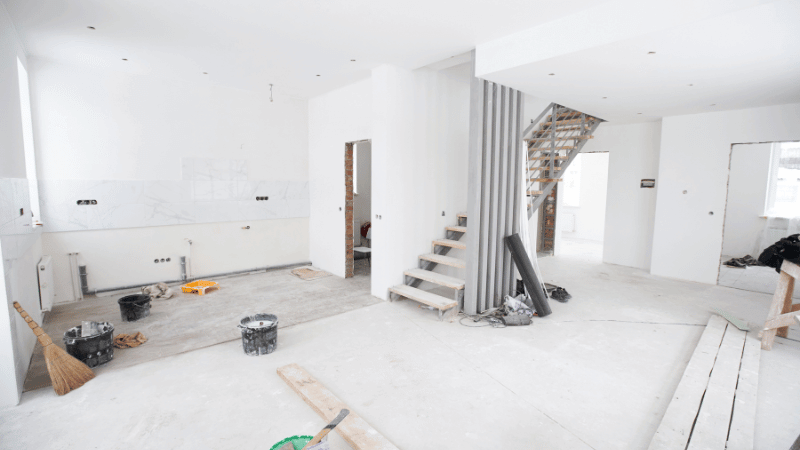Categories
How To Get a Loan for an Unmortgageable House

You can get finance to buy an unmortgageable house - but not necessarily via the traditional 'mortgage' route...
Bargain-hunting property investors love unmortgageable properties. Packed with potential: competing buyers are scared off by the difficulties in securing finance.
But how can you ensure you don’t get caught in the trap – committed to buying a house where you can’t get a mortgage (or only at punitive rates)?
Do you see a potential dream home where others see a leaky barn, an overlooked workshop or a rat-infested, boarded-up terrace?
For entrepreneurial optimists, we flag all the warning signs you need to be aware of, such as whether a property is unmortgageable, and then give you solutions for how to still buy it.
Related: How to Improve Your EPC Rating: The Landlord’s Guide
Skip to:
What Makes a Property Unmortgageable?
Unmortgageable Auction Properties
- Mortgages for Properties with No Kitchen or Bathroom
- Properties with Structural Damage
- Houses in Close Proximity to Commercial Properties
- Low-Value Properties
- Short Lease Properties
- High-Rise Flats
- Ex-Local Authority Housing
- Non-Standard Construction Properties
- Houses with Environmental Issues
How To Buy an Unmortgageable House
Do You Need a Mortgage or a Bridging Loan?
Why Traditional Lenders Probably Can’t Help You With Renovation Finance
What is Considered an Unmortgageable House?
It’s derelict!
You know (and mortgage lenders know) what derelict looks like: run-down, empty, boarded up, and not in “habitable condition.” It can’t be lived in… hygienically or safely.
The technical definition of a property “not in habitable condition” is that it’s derelict, not wind and watertight, needs conversion or doesn’t have a working kitchen or bathroom.
Most high street banks and building societies won’t offer mortgages on properties like these.
Unmortgageable Auction Properties
These properties are unmortgageable due to time constraints.
Property auctions are great places to pick up bargains, including deceased estates and derelict and repossessed properties. But you need to pay 10% of the sale price when the hammer falls, and usually the remaining purchase cost within 28 days.
- It’s often too quick to arrange a standard mortgage, even if the property is considered “mortgageable” and meets the lender’s valuation criteria.
- Most high-street lenders will say it takes “four to six weeks” to set up a mortgage, but experienced buyers will tell you to allow at least a couple of months to accommodate the special circumstances that seem to crop up in most mortgage applications.
- Don’t be led astray by assurances of mortgage offers within 48 hours: that’s not a complete application approval.
- The “auction finance” offered by auction houses will be bridging finance, secured loans, or possibly buy to let mortgages, not necessarily at the most competitive market rates.
An experienced property finance broker can arrange competitive bridging finance for you for an auction purchase.
Looking for a Bridging Loan?
Get started with our calculator
Properties with No Kitchen or Bathroom
While renovating, you may be happy to make do with a camping toilet and Primus stove, but a mortgage lender won’t be so willing to compromise.
The lack of a proper working bathroom or hygienic kitchen renders a property technically uninhabitable – and therefore unmortgageable.
The same goes for a new-build property that’s come onto the market as a forced sale because the developer has run out of finance if it doesn’t have a finished, usable kitchen.
Related: How to Secure a Mortgage for a Property Without a Kitchen & How much value can a new kitchen add to my house?
An extra kitchen!?
Conversely, too many kitchens can be a red flag to mortgage lenders.
A property with more than one kitchen (like Ed ‘Two Kitchens’ Milliband’s north London house) may signal to a mortgagor that you intend to subdivide it into two separate units - a red flag on a standard mortgage application.
Properties with Structural Damage
The signs are usually glaringly obvious: bowed walls, sagging ceilings or door lintels, leaning chimneys, walls separating at the corners, large horizontal cracks…
Rotten joists and subsidence don’t just indicate that you’re looking at heavy renovation rather than light renovation finance.
The costs of these repairs are often hard to estimate, which may mean that mortgagors will be unwilling to lend or that your field of prospective lenders will be severely limited.
Watch our case study video below of how our clients secured a property at auction with a bridging loan:
Houses in Close Proximity to Commercial Properties
Flats above commercial premises, houses in streets with pubs, garages or supermarkets…
You might be happy to overlook any shortcomings in a property’s location to buy somewhere affordable.
A mortgage lender will be concerned about the next buyer: will there be enough equally willing buyers to ensure that the property will sell quickly if, for any reason, you default on the mortgage and they need to reclaim their investment?
Low-Value Properties
Ironically, you’ll struggle to get mortgage finance for an absolute rock-bottom bargain property valued at less than £50K. The reason is because the loan size is too small to justify the mortgagor’s administrative work.

Short Lease Properties
Regarding leasehold properties, anything less than an 80-year lease is considered a “short” lease and considerably devalues a property.
- Properties with less than 60 years on the lease will be virtually unmortgageable.
- Anyone who has owned a leasehold property for at least two years is legally entitled to have 90 years added to their lease for a fair market price.
- (Extending leases with less than 80 years to run is considerably more expensive due to the effect on the property’s value).
- Purchasing a property with a “short lease”: if the vendor has owned the property for more than two years, they can instigate Section 42 proceedings to start the lease extension process, assigning the benefit to you.
- Using a bridging loan to finance the purchase, lease extension, and remortgage costs may be feasible, taking advantage of the uplift in the property's value.
In June 2019, the government announced its intention to ban the sale of new buildings as leasehold properties, citing sharply escalating ground rents as a reason for the damage to the resale value of new buildings.
High-Rise Flats
Historically, lenders have been concerned about high-rise flats retaining their value in a downturn. They also voice concerns about maintaining high-rise communal areas out of homeowners’ control.
- Lenders can be reluctant to grant mortgages on high-rise flats
- Criteria vary but can range from above the fourth to above the 20th floor
- The number of surrounding units owned by one landlord
It can be argued there’s possibly a dose of prejudice behind this, associating high-rises with local authority housing. Especially considering the high-spec high-rise developments such as Manchester’s Deansgate, Jackson’s Row, and London’s Diamond Tower and Mapleton Crescent.
Ex-Local Authority Housing
Another housing type that lenders can be reluctant to lend to is some former council houses.
If you have difficulties finding finance, the pool of future buyers who will purchase from you may be equally restricted.
- Lenders’ criteria may include the concentration of rented local-authority housing in the surrounding area.
Non-Standard Construction Properties
Mortgage lenders like easy-to-sell properties. However, lending for non-standard construction materials and prefabricated construction types can be difficult.
Construction materials which have fallen out of favour include:
- Concrete (despite the high value of apartments in London’s iconic Barbican complex)
- Traditional thatched roofs
- Cornish Units
- AGM Modular
- Reema Hollow Panel
- Woolaway House
- Tarran Clyde House
Strictly speaking, these properties are usually hard-to-mortgage rather than unmortgageable.
The pool of lenders is more limited, but a well-connected property finance broker should be able to connect you with a lender experienced with your property type.

Houses With Environmental Issues
It’s vital to look beyond the walls of the house you want to buy.
The plant life and geology of the property, your neighbours’ properties, and the surrounding area significantly affect whether you may get mortgage finance.
Adverse factors:
- Invasive Japanese knotweed
- Subject to flooding or land erosion
- Near a landfill, waste location or any large-scale excavation
Rental Properties with Low EPC
The government recently introduced new regulations for rental properties with low energy performance certificates (EPC). From December 2025, rental properties will need to have an EPC rating of C or above to take on a new tenancy, and this will then become mandatory for existing tenancies from 2028.
After 2025, getting a buy-to-let mortgage on a property with a low energy efficiency rating will become difficult. To tackle issues like this, you'll need to refurbish the property to improve its EPC rating to take on new tenants.
See similar: Buy to let EPC loan for landlords
How To Buy an Unmortgageable House
In short, you'll need a short-term loan (AKA a bridging or development loan) to buy the house before you later refinance with a standard mortgage once you've completed renovation work.
So, is the work required to do a light or heavy renovation?
A light renovation or refurbishment
- A smaller project where no planning permission is required
- Building regulations do not apply
- There’s no change to the nature of the premises (you’re not converting a barn into a house, for example)
A heavy refurbishment
- The works will cost more than 15% of the property’s value
- Structural work is required
- Planning permission will be needed
- Building regulations apply
The criteria for light and heavy refurbishments vary from lender to lender. If you’re turned down for a light refurbishment loan, you may need to apply for heavy refurbishment lending, which will entail additional survey fees.
If there’s a chance of this, a good mortgage broker will take your application to a lender who handles both types of lending.
Related: A full guide to your next property renovation
Do You Need a Mortgage or a Bridging Loan?
Even if it is possible to find a mortgage lender for your house, the rates offered on a dilapidated property will be high, and this may not be the best route to take.
Bridge finance has a reputation for being an expensive, specialist finance tool. But when used appropriately, it can work out cheaper for you. It's also fast and flexible to arrange.
- If you purchase your property with bridging finance, the ability to “roll up” the interest on the loan (to be repaid at the end) leaves you maximum working capital to fund your renovation.
- The maximum term on a residential bridging loan is usually 12 months, with no early-exit fees.
- As soon as you’ve completed the essential works to bring the property up to “mortgageable” standard, you can exit onto a mortgage, taking advantage of the uplift in value of your property to gain a more favourable long-term mortgage rate.
- A lower LTV gives you access to cheaper borrowing as soon as the work is completed—without paying the early repayment penalty charges that standard mortgage finance would incur.
Related: NEWS: Heavy refurb finance up to 90% gross LTV from £200k now available

Speed
- Bridging loan approvals depends chiefly on a straightforward valuation of the property offered as security for the loan rather than assessing your earnings and creditworthiness.
- Short-term bridging finance can be arranged quickly – within a matter of weeks, and occasionally literally within a week.
Flexibility
Bridge loans can be used for:
- Buying property at auction and the cost of renovations
- Self-build projects
- Residential property conversions
- Finance can usually be repaid any time after a month, and you only pay (by the day) for the amount of time you’ve had the loan.
Why Traditional Lenders Probably Can’t Help You With Renovation Finance
The first port of call for many home renovators will be their bank or another high-street bank or building society. For various reasons, they’re seldom the best sources of finance for renovation projects.
Unsympathetic to inexperienced applicants: high-street lenders operate according to strictly defined lending criteria. Applicants who don’t have the required building experience are unlikely to be given the green light.
Picky about properties: traditional lenders’ definitions of properties they classify as unmortgageable include):
- Anywhere valued at less than £50,000
- Properties with structural issues (problems with foundations, load-bearing walls, roof framing, etc.)
- Properties that are derelict or without a functioning bathroom or kitchen
Lack of urgency: conventional high-street mortgage applications can take up to three months to be approved, and more complex renovation projects are even more challenging for their underwriters.

Finance from specialist lenders
Private banks and independent finance groups take a bespoke approach to lending decisions. They can consider each application on its merits, and if it doesn’t meet their criteria in one area, they may be persuaded that other factors are more favourable.
This flexibility works well for borrowers with non-standard financial circumstances or unusual project setups. However, it doesn’t work well on templated price comparison sites.
As a result, many specialist lenders can only be approached through broker intermediaries, who are expected to have detailed knowledge of various financial products across the property finance market.
They can recommend the lenders most likely to approve your application and offer the most favourable terms. This saves you time and money when arranging lending over the lifetime of your borrowing.
Applying for Renovation Finance
No two property renovation projects are the same, so you need finance that works for your particular circumstances and building plans. Renovations can easily run over time and budget, at which point the cost of your finance becomes a critical success factor.
At Clifton Private Finance, we have an award-winning bridging team dedicated to driving results. We have relationships with lenders across the whole bridging market and have access to the best deals. Our bridging brokers can guide you through the process and liaise with lenders on your behalf.
To see what we can do for you, call +44 203 900 4322 or book a free consultation below.











